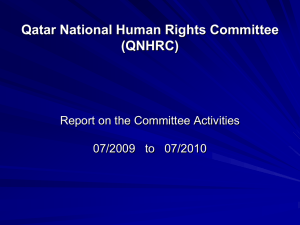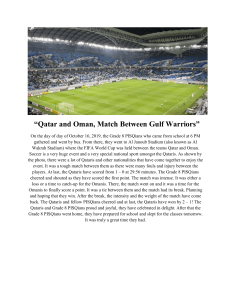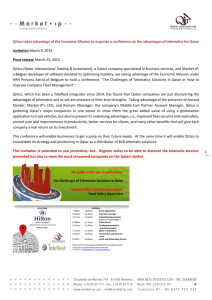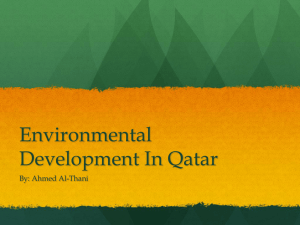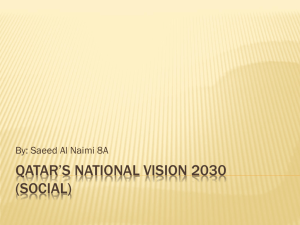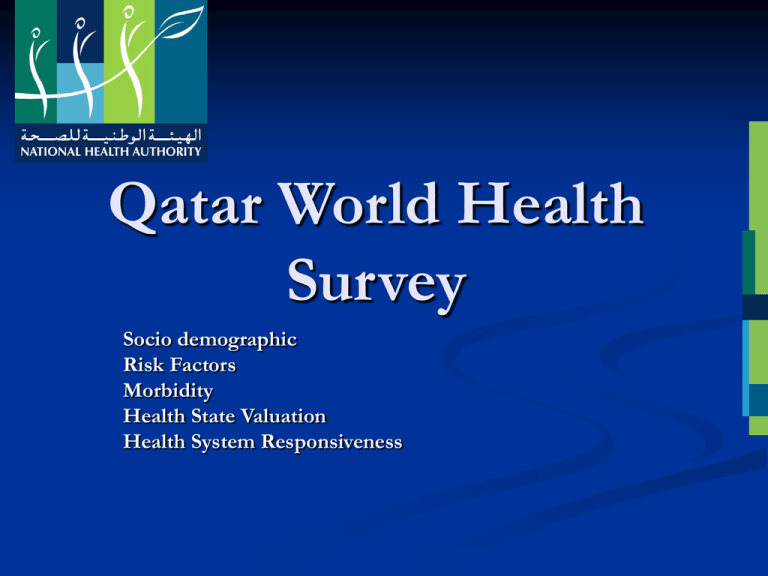
Qatar World Health
Survey
Socio demographic
Risk Factors
Morbidity
Health State Valuation
Health System Responsiveness
Qatar World Health
Survey
Socio demographic
Derived Variables
All tables use similar questions:
Gender
Nationality status
Taken from individual questionnaire – self-report
Age
Divided into groups
Wealth Quintile
Region
The 10 regions of Qatar were reduced to three:
Doha, Al Rayyan and all other
Population Pyramid by Nationality
85+
80-84
75-79
70-74
65-69
60-64
55-59
Age Group
Female
Male
Male
50-54
45-49
40-44
35-39
30-34
25-29
20-24
15-19
10-14
5-9
0-4
7
6
5
4
3
2
1
0
1
2
Percentage of Population
Qatari Males
Non-Qatari Males
Qatari Females
Non-Qatari Females
3
4
5
6
7
Region of Residence
Male
Doha
46.2
Al Rayyan
37.4
Other Regions 16.4
Female
45.8
38.3
15.9
Qatari
30.4
49.1
20.5
NonQatari
56.2
30.5
13.3
Total
46.0
37.9
16.1
Professions
A third of non-Qataris stated that they were
professionals, compared with 23% of Qataris
The largest proportion of Qataris were clerks,
with 30%
Females most likely to be professionals or clerks,
with males spread more evenly between
professionals, legislators, clerks or service
workers
Qatar World Health
Survey
Risk Factors
Background
One person in the household asked questions about
their risk behaviours
Height and Weight measurements taken
Smoking
Nutrition
Physical Activity
Of individual
Of a randomly selected child under 5
Blood pressure measurements and blood sample taken
from the adult
Blood chemistry analysed
Smoking
11% admitted to being a daily smoker
2.6% to smoking, but not daily
Mainly males – almost 20% of males smoke an average
of 16.5 units of tobacco a day
Qataris smoke a greater amount than non-Qataris if
they are daily smokers
The average amount smoked increases with age
Most common use of tobacco is manufactured
cigarettes
Percentage smoking by age and sex
30
Male
Percent Smoking
25
Female
20
15
10
5
0
18 to 19
20 to 29
30 to 39
40 to 49
Age Group
50 to 59
60 to 69
70+
Adult Obesity
Individual weighed and height taken
BMI calculated:
Weight/Height2
Those with a BMI between 20 and 25 classified
as normal weight
25 to 30 are overweight
Over 30 are obese
Over 40 are morbidly obese
Adult Obesity
Only a quarter of adults are in the normal
weight range
39% are overweight
32% are obese
Qatari nationals are more likely to be obese –
40% are in this category
28% of non-Qataris
Proportion of normal birth weight adults falls as
age increases
Childhood Obesity
If household has a child under 5 this child was measured
Number of households with a child under 5 did have a child’s
measurements recorded
Kish grid used if more than one child
Lots of children under 1 year old omitted
Child’s BMI calculated from their height and weight and
compared to WHO growth standards for a child the same age
Results are the z-scores away from a standard reference child
Positive z-scores indicate larger BMI then the reference, negative a
smaller BMI
Scores above +2 indicate a very large BMI for their age
Scores below -2 indicate a very small BMI for their age
Childhood Obesity Results
43% of children within normal range
16% are very large for their age
13% very small
Qatari children less likely to be smaller than
non-Qatari children
As the age of the child increases, they are more
likely to be larger than the reference group of
children
Qatar World Health
Survey
Morbidity
Blood Pressure
Average blood pressure at the higher end of normal
Higher for men than women
Increases with age
14% have a high B.P. and can be diagnosed as hypertensive
Males much more likely than females to have a high B.P.
15% of non-Qataris are hypertensive, compared to
13% of Qatari's
Hypertension increases with age, with 6% of 18 to 29
years olds and 47% of over 60’s with a high blood
pressure
Diabetes
Random Blood Sugar tests indicate that:
6% of adults are classified as having diabetes
10% are in the stage before diabetes with a raised
level of sugar in the blood
Higher percentage of males and Qataris in the
diabetic group
Diabetes and prediabetes increases with age
Qatar World Health
Survey
Health State Valuation
Domains
9 domains of health
Mobility
Self-care
Pain and Discomfort
Cognition
Interpersonal Activities
Breathing
Sleep and Energy
Affect
Vision and Hearing
General Health Rating
87% said that they were very good or good
11% moderate and 1.8% bad or very bad
Men gave themselves a higher rating than females –
49% in the very good category compared with 39% of
women
Non-Qataris happier with their health than Qataris –
90% in top two categories while only 83% of Qataris
Satisfaction falls as age increases
Qatar World Health
Survey
Health System Responsiveness
Self-Assessed Health
Respondents were asked to rate their health:
‘In general, how would you rate your health today?’
5-point scale ranging from very good to very bad
44% very good;
43% good;
11% moderate;
1.5% bad; and
0.3% very bad
Responsiveness tabulated with these responses
Need for Health Care
66% of respondents needed any sort of health
care in the last 3 years (out/inpatient)
99% of those who needed health care stated that
they obtained it!
Satisfaction with Health Care
Patients were asked to rate the health care on
seven different aspects:
Waiting time
Experience of greeting
Explanations by health providers
Involvement in decision making
Privacy
Freedom to choose health providers
Cleanliness of rooms, including toilets
Satisfaction with Health Care
Services
The Satisfaction with Health Care Services
70
61.77
60
50
40
30
20
18.88
8.18
10
9.06
2.1
0
Very Satisfied
Satisfied
Neither Satisfied nor Unsatisfied
Dissatisfied
Very Dissatisfied


